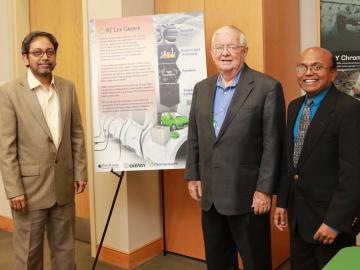Filter News
Area of Research
- (-) Materials (39)
- (-) Neutron Science (10)
- Advanced Manufacturing (3)
- Biological Systems (3)
- Biology and Soft Matter (1)
- Building Technologies (2)
- Chemical and Engineering Materials (2)
- Chemistry and Physics at Interfaces (6)
- Clean Energy (41)
- Computational Chemistry (1)
- Energy Frontier Research Centers (7)
- Functional Materials for Energy (6)
- Fusion Energy (1)
- Geographic Information Science and Technology (2)
- Isotope Development and Production (1)
- Materials Synthesis from Atoms to Systems (5)
- Materials Under Extremes (6)
- Neutron Data Analysis and Visualization (2)
- Nuclear Science and Technology (6)
- Quantum Condensed Matter (2)
- Reactor Technology (1)
- Supercomputing (20)
- Transportation Systems (2)
News Type
News Topics
Media Contacts

An international team led by Gaute Hagen of the Department of Energy’s Oak Ridge National Laboratory used America’s most powerful supercomputer, Titan, to compute the neutron distribution and related observables of calcium-48

Designing alloys to withstand extreme environments is a fundamental challenge for materials scientists. Energy from radiation can create imperfections in alloys, so researchers in an Energy Frontier Research Center led by the Department of Energy’s Oak Ridge National ...

RJ Lee Group has signed an agreement to license an invention developed at the Department of Energy’s Oak Ridge National Laboratory that converts waste rubber into a valuable energy storage material.
The technology turns rubber sources such as tires into carbon blac...

The Department of Energy’s Oak Ridge National Laboratory hopes to add a second target station at its Spallation Neutron Source (SNS) in the next 10 years in order to enhance capabilities of in-depth studies of the molecular structure of materials.
Ken Herwig of O...

Advances in ultrathin films have made solar panels and semiconductor devices more efficient and less costly, and researchers at the Department of Energy’s Oak Ridge National Laboratory say they’ve found a way to manufacture the films more easily, too.
Typically the films—used b...

Engines, laptops and power plants generate waste heat. Thermoelectric materials, which convert temperature gradients to electricity and vice versa, can recover some of that heat and improve energy efficiency. A team of scientists at the Department of Energy’s Oak Ridg...

Quasiparticles—excitations that behave collectively like particles—are central to energy applications but can be difficult to detect. Recently, however, researchers have seen evidence of quasiparticles called negative trions forming and fading in a layer of semiconducting mate...

Plants and other biomass can be converted into a variety of renewable high-value products including carbon fibers, plastics, and liquid fuels such as ethanol and biodiesel that are beneficial for reducing petroleum use and vehicle emissions. Breaking down plants in order to release...

Steady progress in the development of advanced materials has led to modern civilization’s foundational technologies—better batteries, resilient building materials and atom-scale semiconductors. Development of the next wave of materials, however, is being slowed by the sheer co...

The efficiency of solar cells depends on precise engineering of polymers that assemble into films 1,000 times thinner than a human hair.
Today, formation of that polymer assembly requires solvents that can harm the environment, but scientists at the Department of En...




